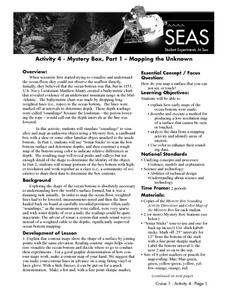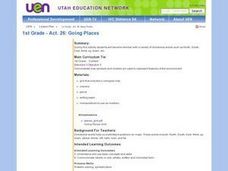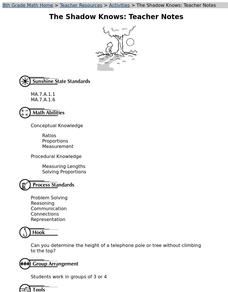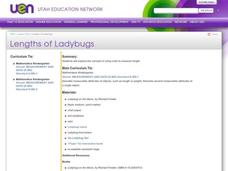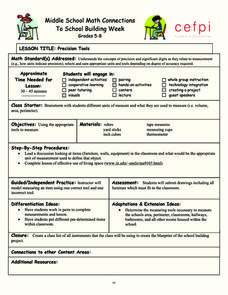Curated OER
Measurement
First graders participate in various activities dealing with measurement, length, volume, and temperature. They identify the need for standard units of measure, sort and classify objects, measure distances, and use a thermometer.
Curated OER
Cool to Rule: A Game of Prediction and Measurement
Pupils demonstrate measurement and estimation skills. In small groups, they are given a measurement, predict what object in the classroom is equal to that specific measurement, and record their data in a table that includes the...
Curated OER
The Heat is On
Third graders experiment with heat through investigations. They rub objects together and compare the relative differences in the amount of heat given off. They write in their journals about the results they find.
Curated OER
State Your Position
Middle schoolers practice using a global positioning system. They discuss the use of celestial objects as navigation points and its problems. They list the advantages and disadvantages of GPS as well.
Curated OER
Worms and more
Students have early length experiences must develop an awareness of what length is, and of the range of words that can be used to discuss length. Young children usually begin by describing the size of objects as big and small. They...
Curated OER
The Great Cover Up!
Students use non-standard measurement tools such as body parts, beans and counters to find the area of shapes drawn on the floor. They continue to determine the area of other objects in the classroom.
Curated OER
Mapping the Unknown
Students explain how early maps of the ocean bottom were made. They describe and execute a method for producing a low-resolution map of a surface that cannot be seen or touched. Students analyze the data from a mapping activity and...
Curated OER
Astronomy: Picture Time
Students investigate how to tell time by observing the placement of objects in the sky. Researching on the Internet, they locate the time for sunrise and sunset, the time the full moon rises, and the difference between clock and solar...
Curated OER
Using Circumference
Learners participate in a lesson that covers the concept of finding the circumference of a circle. The teacher covers relevant vocabulary with the students. They work in groups to measure objects and calculate the formula to find the...
Curated OER
St. Patrick's Day Venn Diagram
In this St. Patrick's day worksheet, students bring to class objects that are green, gold, or shiny. Students sort the items into their groups and then use the worksheet to record the data.
Curated OER
Environment: Going Places
First graders learn directional words and apply this skill to map making. They record their steps on paper.
Curated OER
Speed Trap
Students conceptually explore motion graphing by producing motion at different speeds and directions. They experience the lab and then graph the motion of the truck at various speeds and directions. The procedures of velocity are...
Curated OER
The Shadow Knows - Measuring Other Students
Eighth graders measure height and shadow length of other students on a sunny day and develop a ratio. They apply the ratio to other students and objects using shadows to determine height.
Curated OER
Circumlocution
Young scholars describe unfamiliar objects and situations using existing vocabulary and circumlocution techniques.
Curated OER
Can You Tell By Touch?
Students feel inside a bag and use only their sense of touch to describe and identify one of the objects that is inside the bag.
Curated OER
Are You Coordinated?
First graders are introduced to a coordinate graph. They are given a graph and follow directions to place stickers in the designated blocks. They write coordinate points to identify the placement of their stickers.
Curated OER
ndirect Measurement Technique: Using Trigonometric Ratios
Ninth graders find the height of an object that would be difficult or impossible to measure directly. They construct and use a Clinometer to measure the angle of elevation (or depression). Students create a sketch of the measurement...
Curated OER
Trigonometric Applications Outside the Classroom
Fifth graders describe and demonstrate how trigonometry can be used to find the height of a tall building or tree. They describe and demonstrate how trigonometry can be used to find the height of a high hill, or other high object where...
Curated OER
Lengths of Ladybugs
Students are read a book about ladybugs. Using the test, they estimate which page shows the longest trip the ladybug made. They assemble their own ladybug book by following directions on a worksheet. They take measurements on each...
Curated OER
Sound
Second graders study how sound is produced by vibrations and is transmitted through matter in all directions. They observe how sounds are produced and identify the ways in which sound travels.
Curated OER
Is It Hot in the Light?
Third graders make observations about the temperature of items in direct sunlight. In groups, they discuss why asphalt, brick and cement are warmer than items surrounding them. To end the lesson, they examine how heat transfers energy...
Curated OER
Precision Tools
Students discuss the appropriateness of using a specific tool to measure and define an object. After measuring the area of their classroom and the objects in it with the appropriate tools, they create a floor plan that makes the most...
Curated OER
Trace a Face
Students find two dimensional shapes in three dimensional figures. They determine the shapes that make up the faces of three dimensional figures of common classroom objects such as crayon boxes.
Curated OER
Welcome to My Neighborhood
Students create pictures of neighborhoods and label the people and objects with Spanish words and phrases.
Other popular searches
- Indirect and Direct Objects
- Direct Objects Grammar
- Verbs and Direct Objects
- Spanish Direct Objects
- Direct Objects in English
- Language Arts Direct Objects
- Direct Objects English
- Direct Objects Verbs
- Direct Objects in Sentences
- German Direct Objects
- Compound Direct Objects
- Direct Objects Recognize






